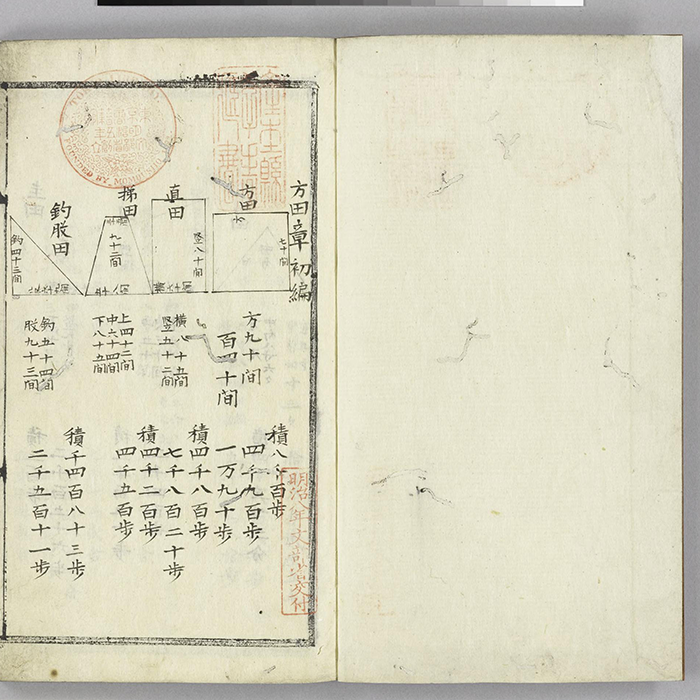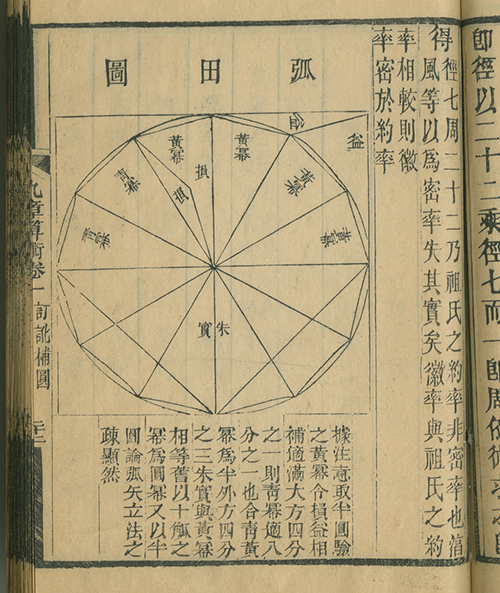- About MAA
- Membership
- MAA Publications
- Periodicals
- Blogs
- MAA Book Series
- MAA Press (an imprint of the AMS)
- MAA Notes
- MAA Reviews
- Mathematical Communication
- Information for Libraries
- Author Resources
- Advertise with MAA
- Meetings
- Competitions
- Programs
- Communities
- MAA Sections
- SIGMAA
- MAA Connect
- Students
- MAA Awards
- Awards Booklets
- Writing Awards
- Teaching Awards
- Service Awards
- Research Awards
- Lecture Awards
- Putnam Competition Individual and Team Winners
- D. E. Shaw Group AMC 8 Awards & Certificates
- Maryam Mirzakhani AMC 10 A Awards & Certificates
- Two Sigma AMC 10 B Awards & Certificates
- Jane Street AMC 12 A Awards & Certificates
- Akamai AMC 12 B Awards & Certificates
- High School Teachers
- News
You are here
A Classic from China: The Nine Chapters - Introduction and History
Introduction
This article is about the most important mathematical work in China’s long history, the Jiuzhang Suanshu (“Nine Chapters on the Art of Calculation”). The book was used throughout China for centuries, and it also circulated in Korea and Japan, influencing mathematics there. The author(s) and date(s) of the original work are no longer known, but clues in the text—including the units used in story problems—indicate that it was probably written shortly after 200 BCE. The original version of the Nine Chapters presented rules and algorithms but without formal proof or derivation. Later, in the year 263 CE, the mathematician Liu Hui provided a written commentary that included justification for the techniques used.
China, a large region with an immensely long history, has played a big role in many spheres of culture. In mathematics and other sciences, China has also played an advanced world role. This is not a new development. In fact, the Needham Research Institute in Cambridge, England, has been working for decades to summarize the rich history of China’s contributions to science and technology. So far, the summary occupies over 20 large published volumes; volume 3 is on mathematics. (Editor's note: As of 2018, the series consists of 27 volumes, the most recent one published in 2015.)
Looking over portions of the Nine Chapters, and solving some of the story problems in it, is a good way to see how the development of mathematics in Asia was shaped by how life and society were organized there. Life in the West and in the East have had similarities and differences, so we can expect that the mathematics of these two cultures will also have some similarities and some differences.
In subsequent sections of this article, I’ll provide some background about the book and then present 10 story problems from it. I challenge you, the reader, to solve as many of the problems as you can. All 10 problems are drawn from the edited translation by Shen Kangshen, et al. (1999).

Above: The opening page of Sankei kyusho, a book from Edo-period Japan (1603-1867) that is modeled after The Nine Chapters (in fact, the Japanese word kyusho means “nine chapters”). The author and date of the book are unknown. (Source: Mathematical Treasure: The Chinese Nine Chapters in Japan, MAA Convergence)
The Nine Chapters versus Euclid's Elements
Of the works considered China’s Ten Mathematical Classics, the Nine Chapters is the oldest and the most influential. Like Euclid’s Elements in the West, it was used as a basic textbook for mathematics from ancient times all the way to 1600 CE and even later.
Comparing these two works, we can’t help but notice some differences between the roots of Eastern and Western mathematics:
- The Nine Chapters was focused more on practical problem-solving than on theory. It is a how-to manual consisting of 246 exemplary problems and their solutions. After a few problems of a given type were solved, the general method of solution was summarized. By contrast, the Elements was a rigorous development of the structure of geometry and some related fields, with theorems built up in a careful manner from a foundation consisting of basic “elements” (axioms and postulates). The style of the Nine Chapters was inductive; the Elements, deductive.
- In ancient times, Asians were far more adept at arithmetic and computation than were Westerners. The Nine Chapters used decimal place-value arithmetic at a time when Europeans were still using Roman numerals or other cumbersome systems. The ancient Chinese were also the first of the two to use negative numbers, a practice not adopted in Europe until the 1400’s. The Chinese word for mathematics, suanshu, that appears in the title of the Nine Chapters, literally means “the art of calculation”.
- The study of prime numbers, factorization, and other topics in number theory, which was an important part of the Elements and of ancient Greek mathematics, does not seem to have been taken up in traditional Chinese mathematics. For example, in China the greatest common divisor of two numbers was found not by factoring, but by a process of repeated subtraction that was also described by Euclid.
- Centuries before other peoples, the Chinese developed algorithms for solving linear problems, including matrix methods and techniques of excess and deficit.
The Nine Chapters of the Jiuzhang Suanshu
Just how much Chinese mathematics was rooted in practical problem-solving is reflected in the nine chapter subjects of the Jiuzhang Suanshu. The chapters correspond to the nine arithmetical arts of Chinese tradition:
Chapter 1 “Field Measurement”—calculating the areas of various shapes of farming plots such as triangles, rectangles, and circles (using an accurate approximation of \(\pi\)), plus arithmetical rules for fractions and greatest common divisors.

This page illustrates a Chinese version of the exhaustion method for approximating \(\pi,\) based on regular polygons inscribed in or circumscribed around a circle. It appears in a sixteenth-century version of Liu Hui’s third-century edition and commentary on the Nine Chapters, in which he obtained a \(\pi\) approximation of 3.14024. (Source: Mathematical Treasures - Jiuzhang suanshu, MAA Convergence)
Chapter 2 “Millet and Rice”—using ratios and proportions in the commercial exchange of different kinds of grains and other products.
Chapter 3 “Distribution by Proportion”—subdividing quantities by direct, inverse, or compound proportion, plus a discussion of arithmetic and geometric progressions.
Chapter 4 “What Width?”—calculating an unknown dimension of a rectangle or rectangular solid if the area or volume is known, including how to find reciprocals, square roots, and cube roots of various types of numbers.
Chapter 5 “Construction Consultations”—finding the areas and volumes of shapes and solids used in designing buildings and other structures.
Chapter 6 “Fair Levies”—proportionally distributing wages and taxes, continuing Chapter 3.
Chapter 7 “Excess and Deficit”—solving linear equations with arithmetical algorithms and without algebra.
Chapter 8 “Rectangular Grids”—using matrices to solve simultaneous linear equations.
Chapter 9 “Right Triangles”—solving practical geometric problems using properties of right triangles, and quadratic equations by an adaptation of the square-root algorithm.
For centuries, the Nine Chapters was used to train civil servants in the prestigious imperial bureaucracy. This was consistent with Chinese philosophical traditions, in which intellectuals were supposed to use their skills to benefit society in practical ways. For example, a line of hereditary state officials called chouren was specifically charged with “reading the heavens” (studying astronomy) and doing the calculations needed to make calendars, which were so important in this agrarian society. The chouren’s routine need for various kinds of approximations stimulated the development of algorithms that utilized fractional and signed numbers. The word chouren came to mean both “astronomers” and “mathematicians” (Lĭ and Dù, pp. 22-24, 32, 48-49, 232).
Randy K. Schwartz (Schoolcraft College), "A Classic from China: The Nine Chapters - Introduction and History," Convergence (December 2018)




